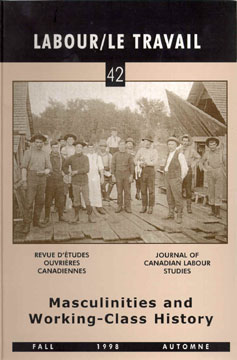Abstract
In March 1919, over 230 union delegates assembled at the Western Labor Conference in Calgary to chart a radical new direction for wage workers through the creation of a revolutionary industrial union centre, the One Big Union (OBU). This essay argues that the practices of the OBU's radical manhood, their particular sense of what it meant to be a union man, shaped the organization's structure and politics as well as the emergent culture which fostered such widespread working-class radicalism. Drawing upon already existing practices espoused by Canadian labourists and American Wobblies as well as fashioning new ones, OBU men distinguished radical manhood from both the class politics and the masculinities of male bosses and scabs. While the organization of working women was not seen as an important issue at the WLC, the upsurge in women's militancy during the labour revolt prompted OBU supporters to encourage these women to join their male comrades. At times, advocates of the One Big Union posed the questions of women's oppression and emancipation as crucial elements of the union's purpose; their infrequent ideological commitment, however, too often failed to translate into organizational gains for working-class women and the development of feminist practices within the union. In their challenge to the bourgeois order, OBU men created a program that, in the prevailing context of gender relations, meant that the One Big Union would bring about the transformation, but not the eradication, of men's power.
Résumé
En mars 1919, plus de 230 délégués syndicaux se réunissent au Congrès du Travail de l'Ouest à Calgary dans le but d'opérer un virage radical chez les travailleurs salariés par la création d'une nouvelle centrale : la One Big Union. Le présent article démontre que dans l'OBU, les pratiques viriles des travailleurs radicaux, leur perception du syndicaliste, vu comme d'abord masculin, moulèrent la structure et les politiques de la nouvelle organisation, de même que la nouvelle culture associée au radicalisme ouvrier. Les hommes de l'OBU, s'inspirant des travaillistes canadiens et des Wobblies américains, tout en forgeant des pratiques inédites, se distinguaient à la fois de la politique de classe des autres syndicats et de la masculinité des patrons et des briseurs de grève. Si le Congrès négligea l'organisation des travailleuses, leur militantisme pendant la révolte ouvrière de 1919 poussa l'OBU à encourager les femmes à se joindre à leur camarades masculins. Pour certains membres de l'OBU, la question de l'oppression féminine constituait un élément fondamental des programmes syndicaux. Ces rares engagements idéologiques n'apportèrent cependant aucun gain pour les femmes de la classe ouvrière, pas plus qu'ils n'inspirèrent de pratiques tant soit peu féministes dans les syndicats. En défiant l'ordre bourgeois,les hommes de l'OBU mirent sur pied un programme qui, dans le contexte des rapports de sexe alors en vigueur, résultèrent en une transformation mais non en l'extirpation du pouvoir masculin.
